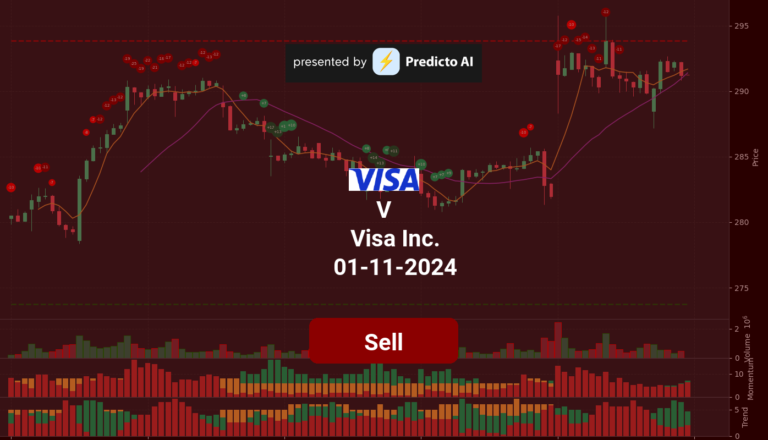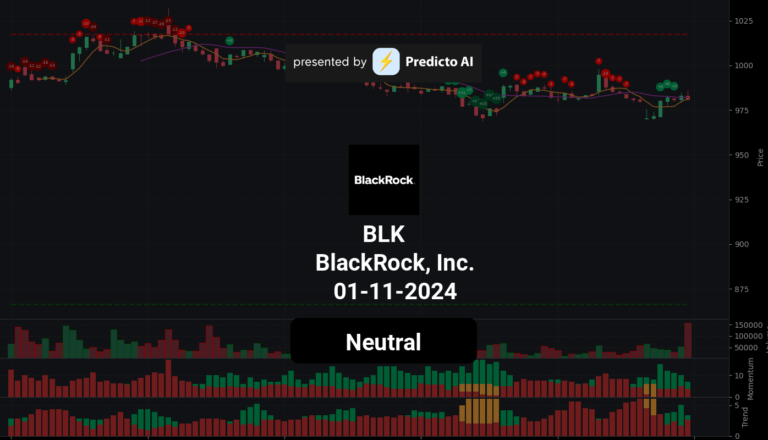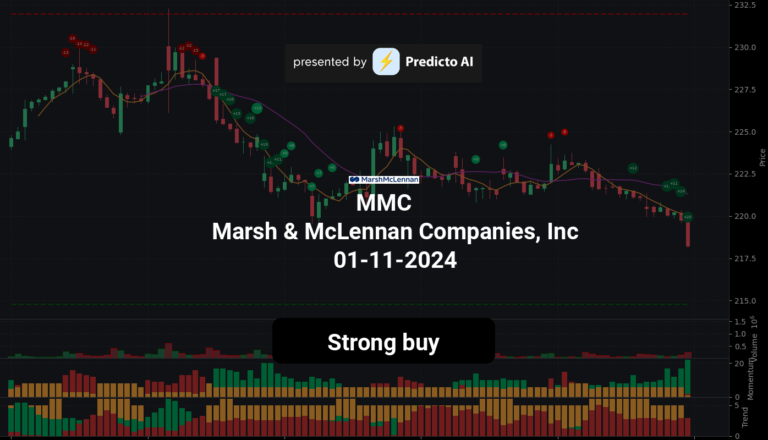VZ Stock Analysis: A Mixed Outlook Ahead!
🔴 Recommendation: Verizon Communications Inc. (VZ) is currently rated as a strong buy, but a closer look reveals a complex investment landscape with both opportunities and significant risks.
📈 Key Highlights:
Momentum Indicators: The stock shows signs of being oversold, with positive signals from the StochRSI and MACD, hinting at potential recovery.
Financial Health: Despite a solid revenue base of $32.80 billion, concerns arise from declining net income and high debt levels.
Valuation Metrics: A forward P/E ratio of 9.17 suggests potential undervaluation, but the Price-to-Sales ratio of 1.35 raises questions about future performance.
⚠️ Caution Flags:
Bearish Trends: The stock is currently below key moving averages, indicating a strengthening bearish trend.
Liquidity Risks: A current ratio of 0.13 points to potential challenges in meeting short-term obligations.
As we delve deeper into the details, we will break down the price trends, indicators, financial health, valuation metrics, and more to provide a comprehensive analysis of Verizon’s stock performance. Stay tuned! 👇
VZ Price Analysis

| Positive Momentum Signals | Negative Momentum Signals | Hold Momentum Signals |
|---|---|---|
|
|
|
| Positive Trend Signals | Negative Trend Signals | Hold Trend Signals |
|---|---|---|
|
|
|
Verizon Communications Inc. (VZ) presents a complex investment landscape characterized by both potential opportunities and significant risks. Currently, the stock is rated as a strong buy, indicating some analysts see value in the current price levels. However, a closer examination of the momentum and trend indicators reveals a mixed picture.
On the positive side, momentum indicators such as the StochRSI and WaveTrend suggest that the stock is oversold, which could indicate a potential bottom and an opportunity for recovery. The RSI is also showing a moderately bullish trend, hinting at possible upward movement in the near future. Additionally, the MACD has shown a positive histogram crossover, which is typically a bullish signal.
Conversely, there are several negative momentum indicators that investors should be cautious of. The StochRSI has recently experienced a bearish crossover, and the WaveTrend is displaying a bearish divergence, suggesting a potential reversal in price direction.
From a trend perspective, the stock is currently facing significant headwinds. The price is below the 50-day and 200-day EMA, indicating a bearish trend that is strengthening. The presence of a Death Cross, where the 50-day EMA has crossed below the 200-day EMA, serves as a strong bearish signal. Furthermore, the price is below the Supertrend indicator, reinforcing the bearish outlook.
In summary, while Verizon’s stock may appear attractive at a glance due to its strong buy rating and oversold conditions, the underlying momentum and trend indicators suggest a cautious approach. The combination of bearish trends and potential reversal signals indicates that investors should be vigilant. A hold or cautious buy strategy may be prudent until clearer signs of a turnaround emerge.
VZ Fundamental Analysis
VZ’s recent financial performance presents a mixed picture, with several concerning indicators overshadowing some positive aspects.
The company’s net income for the most recent period stands at $4.59 billion; however, the year-over-year trend shows a decline, raising significant concerns about its future profitability. Additionally, VZ’s average net debt is notably high at $147.17 billion, which necessitates a closer examination of its impact on financial flexibility and the company’s ability to service its debt.
Liquidity appears to be a pressing issue, as indicated by a current ratio of 0.13, suggesting potential challenges in meeting short-term obligations. Furthermore, the cash to total assets ratio of 0.01 reflects limited financial flexibility, making the company vulnerable to economic shocks.
On the valuation front, the forward P/E ratio of 9.17 suggests that VZ may be undervalued relative to its earnings, which could present a buying opportunity. However, the price-to-sales ratio of 1.35, combined with a decline in revenue growth, raises questions about the stock’s future performance.
The company’s year-over-year revenue growth of -0.56% indicates a decline, which could negatively impact stock price. Despite this, VZ boasts an impressive operating margin of 100.00%, reflecting efficient operations and strong cost control, while the net profit margin of 14.00% indicates solid profitability after expenses. However, the earnings growth of -0.90% suggests challenges in maintaining growth momentum.
Shareholder concerns are also evident, with an average ordinary shares outstanding of 4.21 billion indicating potential dilution, which could affect shareholder value. Additionally, the average treasury shares of 85.20 million suggest limited buyback activity, which may not support stock price appreciation.
From an income statement perspective, VZ reported a total revenue of $32.80 billion, showcasing a substantial revenue base. However, the decline in revenue growth and net income trends raises alarms about the company’s ability to sustain profitability moving forward.
The balance sheet reveals a debt-to-equity ratio of -1.82, indicating a high level of leverage that may be unsustainable depending on the company’s industry and profitability. Moreover, the average tangible book value of -$95.89 billion points to negative net worth, raising further concerns about financial stability.
On a more positive note, VZ’s average capital expenditures of $35.32 billion suggest that the company is investing in growth and expansion, which is a favorable sign for future performance. The free cash flow of $8.38 billion is also positive, but the overall cash flow situation should be monitored closely given the high debt levels.
In summary, while VZ exhibits some positive indicators such as strong operating margins and potential undervaluation, the declining revenue and net income trends, coupled with high debt levels and liquidity concerns, lead to a neutral outlook for the stock. Investors should carefully consider these factors before making any investment decisions.
Financial Health
🔴 Net Income for the most recent period was $4.59 billion, but the year-over-year net income trend shows a decrease, raising concerns about future profitability.
🔴 Average Net Debt is high at $147.17 billion, which warrants further investigation into its impact on financial flexibility and debt servicing capabilities.
🔴 Current Ratio of 0.13 indicates potential liquidity risk, suggesting challenges in meeting short-term obligations.
🔴 Cash to Total Assets Ratio of 0.01 reflects limited financial flexibility and vulnerability to economic shocks.
Valuation
🟢 Forward P/E ratio of 9.17 suggests potential undervaluation, indicating that the stock may be a good buy relative to its earnings.
🔴 Price-to-Sales Ratio of 1.35 is moderate, but combined with declining revenue growth, it may not reflect strong future performance.
Growth and Profitability
🔴 Year-over-year revenue growth of -0.56% indicates a decline in revenue, which could negatively impact stock price.
🟢 Operating Margin of 100.00% suggests efficient operations and good cost control, while the Net Profit Margin of 14.00% reflects strong profitability after expenses.
🔴 Earnings Growth of -0.90% indicates challenges in maintaining growth momentum.
Shareholder Information
🔴 Average Ordinary Shares Outstanding at 4.21 billion suggests potential dilution concerns, which could affect shareholder value.
🔴 Average Treasury Shares of 85.20 million indicates limited buyback activity, which may not support stock price appreciation.
Income Statement
🟢 Total Revenue for the most recent period was $32.80 billion, indicating a substantial revenue base.
🔴 The decline in revenue growth and net income trend raises concerns about the company’s ability to sustain profitability in the future.
Balance Sheet
🔴 Debt-to-Equity Ratio of -1.82 suggests a high level of leverage, which may be unsustainable depending on the company’s industry and profitability.
🔴 Average Tangible Book Value of -$95.89 billion indicates negative net worth, raising concerns about financial stability.
Cashflow
🟢 Average Capital Expenditures of $35.32 billion suggest that the company is investing in growth and expansion, which is a positive sign for future performance.
🔴 Free Cash Flow of $8.38 billion is positive, but the overall cash flow situation should be monitored closely given the high debt levels.
Overall, while there are some positive indicators such as strong operating margins and potential undervaluation, the declining revenue and net income trends, along with high debt levels and liquidity concerns, lead to a neutral outlook for the stock.
VZ News Analysis
A mixed outlook for Verizon Communications (VZ) based on recent news.
Summary of Verizon Communications (VZ) news indicates a blend of positive and negative developments. The company’s charitable contributions and bullish outlook from analysts are encouraging, while concerns about returns on capital and significant debt for acquisitions raise caution. Investors should weigh these factors carefully.
🟢 Verizon has donated $50,000 to the Los Angeles Mission, showcasing its commitment to community support and corporate social responsibility.
🟢 Oppenheimer has provided a bullish outlook on Verizon, indicating confidence in its future performance alongside other telecom leaders.
🔴 However, there are warnings regarding Verizon’s returns on capital, suggesting potential inefficiencies that could impact profitability.
🔴 The company is preparing to take on $10 billion in debt for the Frontier acquisition, which could strain its financial position if not managed properly.
🟢 Verizon is also offering relief to customers affected by Hurricane Milton, demonstrating its proactive approach to customer service during crises.
🔴 Despite some positive movements, Verizon’s stock has been rising but still lags behind the broader market, indicating potential challenges ahead.
VZ Holders Analysis
The financial health of VZ presents a mixed outlook for the next month. While there are positive aspects, there are also concerns that could impact stock performance.
🟢 VZ has a **high institutional ownership** at 64.22%, indicating significant interest from large investors. This can provide stability and confidence in the stock’s performance.
🟡 The **very low insider ownership** at 0.04% raises concerns about management’s confidence in the company’s future. This could suggest a lack of alignment between management and shareholder interests.
🟡 The **number of institutional holders** is substantial at 3506, which indicates a diversified ownership base. However, this could also lead to increased volatility if large investors decide to sell.
🔴 Recent **insider transactions** show no significant purchases, and the lack of insider buying could signal a cautious outlook from those closest to the company.
🔴 The **absence of insider purchases** in the last six months may indicate a lack of confidence in the stock’s near-term performance, which could deter potential investors.
VZ Analyst Ratings
The analyst ratings for VZ show a mixed sentiment, with a total of 2 strong buy, 6 buy, 24 hold, 0 sell, and 0 strong sell recommendations. This indicates that while there are some positive views, the majority of analysts are adopting a wait-and-see approach.
🔴 Over the past month, there have been 4 strong buy ratings, 10 buy ratings, 12 hold ratings, 1 sell rating, and 1 strong sell rating. This suggests a slight shift towards a more cautious outlook, as the number of hold ratings has increased.
🟡 Given the recent upgrades and downgrades from various firms, including Tigress Financial and B of A Securities, the sentiment remains cautious. The lack of strong sell recommendations indicates that analysts do not foresee significant downside risk in the near term.
VZ Economic Analysis
Based on the US economic and market data:
🔴 The unemployment rate has increased to 4.3%, up from 4.1% in the previous month, indicating potential weakness in the labor market. This could lead to reduced consumer spending, which may negatively impact Verizon’s revenue growth.
🟡 Retail sales have shown a slight increase, but the overall growth is modest. This suggests that while there is some consumer demand, it may not be strong enough to significantly boost Verizon’s sales in the near term.
🔴 The CPI data indicates inflationary pressures remain, which could lead to increased operational costs for Verizon. Higher costs may affect profit margins, especially in a competitive telecom market.
🟢 However, Verizon’s strong dividend yield of 6.14% remains attractive to income-focused investors, providing some support for the stock price amidst economic uncertainties.
🔴 The overall economic indicators suggest a cautious outlook for the telecom sector, particularly for Verizon, as rising unemployment and inflation could hinder growth.
In summary, while Verizon has a solid dividend and some positive aspects, the recent economic data points to potential challenges ahead, leading to a neutral outlook for the stock price over the next month.
Disclaimer
Investors may consider the AI predictions and news summaries as one factor in their investment decisions alongside their own research and risk tolerance.




